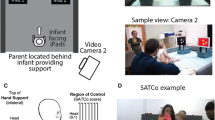Abstract
This study explored the influence of an external support at the thoracic and pelvic level of the trunk on the success of reaching, postural stability and reaching kinematics while infants reached for a toy. Seventeen infants (4–6 months) were clustered into two groups according to their trunk control assessed with the Segmental Assessment of Trunk Control. Major differences were seen between groups with pelvic support, whereas with thoracic support, all infants showed similar quality reaching behaviors. With the external pelvic support, infants who had acquired trunk control in the lumbar region were more accurate in their reaching movements (less movement time, improved straightness of reach, less movement units and increased path length per movement unit) and were more stable (decreased trunk and head displacement) during a reach than infants who had only acquired trunk control in the thoracic region. These results support the hypothesis that trunk control influences the quality of reaching behavior.


Similar content being viewed by others
References
Assaiante C (1998) Development of locomotor balance control in healthy children. Neurosci Biobehav Rev 22(4):527–532
Assaiante C, Mallau S, Viel S, Marianne J, Schmitz C (2005) Development of posture control in healthy children: a functional approach. Neural Plast 12:109–118
Bayley N (1969) Bayley scales of infant development. Oxford University Press, New York
Butler PB, Saavedra S, Sofranac M, Jarvis SE, Woollacott MH (2010) Refinement, reliability, and validity of the segmental assessment of trunk control. Pediatr Phys Ther 22:246–257
de Graaf-Peters VB, Bakker H, van Eykern LA, Otten B, Hadders-Algra M (2007) Postural adjustments and reaching in 4- and 6-months-old infants: an EMG and kinematical study. Exp Brain Res 181:647–656
Fallang B, Saugstad OD, Hadders-Algra M (2000) Goal directed reaching and postural control in supine position in healthy infants. Behav Brain Res 115:9–18
Fallang B, Didrik S, Hadders-Algra M (2003) Postural adjustments in preterm infants at 4 and 6 months post-term during voluntary reaching in supine position. Pediatr Res 54:826–833
Galloway JC, Thelen E (2004) Feet first: object exploration. Infant Behav Dev 27:107–112
Gessell A (1946) The ontogenesis of infant behavior. Manual of child psychology, Wiley
Gessell A, Ames LB (1947) The development of handedness. J Genet Psychol 70:155–175
Grenier A, Amiel-tison C (1981) Liberated-motricity by holding the head during the 1st weeks of life. Arch Fr Pediatr 8:557–561
Grönqvist H, Brodd SK, Von Hofsten C (2011) Reaching strategies of very preterm infants at 8 months corrected age. Exp Brain Res 209:225–233
Hadders-Algra M (2008) Development of postural control. In: Hadders-Algra M, Brogren Carlberg E (eds) Postural control: a key issue in developmental disorders. Mac Keith Press, London, pp 22–73
Hadders-Algra M, Brogren E, Forssberg H (1996) Ontogeny of postural adjustments during sitting in infancy: variation, selection and modulation. J Physiol 493:273–288
Harbourne RT, Giuliani C, Neela JM (1993) A kinematic and electromyographic analysis of the development of sitting posture in infants. Dev Psychobiol 26:51–64
Hirschfeld H, Forssberg H (1994) Epigenetic development of postural responses for sitting during infancy. Exp Brain Res 97:528–540
Hopkins B, Rönnqvist L (2002) Facilitating postural control: effects on the reaching behavior of 6-month-old infants. Dev Psychobiol 40:168–182
Konczak J, Borutta M, Dichgans J (1997) The development of goal-directed reaching in infants II. Learning to produce task-adequate patterns of joint torque. Exp Brain Res 113:465–474
McGraw MB (1945) The neuromuscular maturation of the human infant. McKeith, London
Out L, van Soest AJ, Savelsberg GJP, Hopkins B (1998) The effects of posture on early movements. J Mot Behav 3:260–272
Piper MC, Pinnell LE, Darrah J, Maguire T, Byrne PJ (1992) Construction and validation of the Alberta Infant Motor Scale (AIMS). Can J Public Health 83:46–50
Saavedra S (2009) Contribution of spinal segments to control of posture in typical and atypical development. Doctoral Dissertation, University of Oregon
Saavedra SL, Van Donkeelar P, Woollacott MH (2012) Learning about gravity: segmental assessment of upright control as infants develop independent sitting. J Neurophysiol 108(8):2215–2229
Spencer JP, Vereijken B, Diedrich FJ, Thelen E (2000) Posture and the emergence of manual skills. Dev Sci 3(2):216–233
Thelen E, Spencer JP (1998) Postural control during reaching in young infants: a dynamic systems approach. Neurosci Biobehav Rev 22:507–514
Touwen BCL (1976) Neurological development in infancy. JB Lippincott, Philadelphia
van Balen LC, Dijkstra LJ, Hadders-Algra M (2012) Development of postural adjustments during reaching in typically developing infants from 4 to 18 months. Exp Brain Res 220(2):109–119
Van der Fits IBM, Klip AWJ, Van Eykern LA, Hadders-Algra M (1999a) Postural adjustments during spontaneous and goal directed arm movements in the first half year of life. Behav Brain Res 106:75–90
Van der Fits IBM, Otten E, Klip AWJ (1999b) The development of postural adjustments during reaching in 6- to 8-month-old infants. Exp Brain Res 126:517–528
van der Heide JC, Otten B, van Eykern LA, Hadders-Algra M (2003) Development of postural adjustments during reaching in sitting children. Exp Brain Res 151:32–45
van Haastert IC, de Vries LS, Helders PJM, Jongmans MJ (2006) Early gross motor development of preterm infants according to the Alberta infant motor scale. J Pediatr 149:617–622
van Wullften Palthe T, Hopkins B (1993) A longitudinal study of neural maturation and early mother-infant interaction. J Child Psychol Psychiatry 34:1031–1041
von Hofsten C (1980) Predictive reaching for moving objects by human infants. J Exp Child Psychol 30(3):369–382
von Hofsten C (1982) Eye-hand coordination in the newborn. Dev Psychol 18:450–461
von Hofsten C (1991) Structuring of early reaching movements: a longitudinal study. J Mot Behav 23:280–292
Acknowledgments
This work was supported by the National Institutes of Health Grant 1R01HD062745-01, Marjorie Woollacott, principal investigator, and by the McNair Scholars Program for Francine Porter. The authors would like to thank Wayne Manselle for his valuable help with computer programming and technical assistance.
Author information
Authors and Affiliations
Corresponding author
Rights and permissions
About this article
Cite this article
Rachwani, J., Santamaria, V., Saavedra, S.L. et al. Segmental trunk control acquisition and reaching in typically developing infants. Exp Brain Res 228, 131–139 (2013). https://doi.org/10.1007/s00221-013-3544-y
Received:
Accepted:
Published:
Issue Date:
DOI: https://doi.org/10.1007/s00221-013-3544-y




